
From ancient times until 1028.
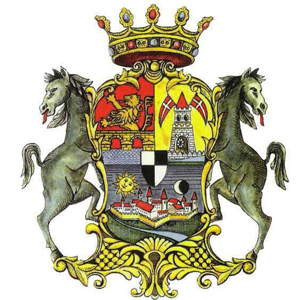
The city of Timisoara has developed on the Timis River Plain, which is crossed by the Timis, Bega river courses and some of their tributaries. Before the great draining works of the eighteenth century, these rivers united their beds by a lot of arms and swamps. The town has appeared on the edge of the swamp, stretching along the rivers Timis and Bega, and dry area, located to the north.
People settled on Timisoara’s current territory 6000 years ago (during the so-called new Stone Age in the Neolithic). It can be said that the history of the people living on this land is older than the history of the city itself. Small settlements emerged, which then disappeared.
Many Roman objects (coins, broken dishes, etc.) have been discovered, which could have reached this area by trade as well. So far traces of Roman buildings have not been found. The oldest “built” construction of large dimensions is the so-called “Roman ditch”, but the exact date of its building is unknown.
Around 1000 the present territory of Banat belonged to the voivodeship led by Prince Glad. There are some researchers who say that Timisoara had already been mentioned in 1020, as belonging to a “Greek” Episcopal Church (Orthodox).

The period of belonging to the Hungarian Kingdom 1028-1552
(since 1541 to the Principality of Transylvania)
In 1028 the plain of Banat was conquered by the Hungarian King’s army.
Most scientists say that the Timis fortress, Timisoara of today, was first mentioned around 1150, in 1177, or only in the XIII century.
Certainly, in 1177 the Timis County (county) is mentioned, which must have had a capital, which could only have been Timisoara.
In that time, Timisoara was formed of a city defended by a wall of earth with wooden palisades, forming a rectangle about 170 x 110 m in plain, located to the north of the Banat Museum, and of a civilian settlement, located to the north of that fortress, in the Libertatii Square area of today.
Hungarian king Charles Robert of Anjou (from a French family, who ruled southern Italy with its capital at Naples / Napoli) built a castle on the site of the current residence of the Banat Museum. It seems that he lived here between 1315-1323. Timisoara developed. If until now Timisoara had been a village, this century it gained a city status.
The next century, Timisoara became a centre for the fight against the Ottomans.
In 1514, the city was besieged by insurgent peasants of Gheorghe Doja, who were defeated.
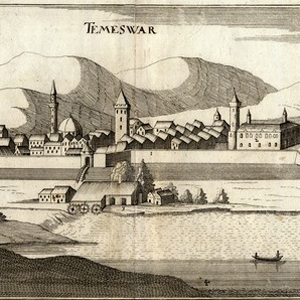
The period of Turkish ruling 1552-1716
The Turks besieged Timisoara in 1551. After a new siege, the city surrendered to the Turks in 1552. The statement that Timisoara was ravaged by the Turks is a legend. Forced or voluntarily, most of the people remained in the city, probably in their homes. Only about 20 to 25 years later, the Turks became the majority in the city. Unlike villages, where the population remained unchanged for hundreds of years, in cities that were administrative and military centres, the changes of government and administration brought, after some time, the change of the population.
Until 1716 Timisoara remained an Ottoman city. The castle on the current museum site, the churches, built until 1552, and then probably the majority of mosques were made of masonry. The dwellings were built of wood. Timisoara was a “wooden town”. Periodically fires occurred.
The Austrian period 1716-1867

In 1716, Timisoara was besieged by the “imperial” Habsburg troops. The city suffered strong artillery bombardment. Much of the wooden buildings were damaged or burned. The Turkish garrison was forced to capitulate. Ottoman soldiers, “curuţii” (anti-Habsburg Hungarian freedom fighters) and Turkish civilians left Timisoara. The Orthodox Christian population, comprised of Romanians and Serbians, as well as the Hebrew people remained here.
After the peace in 1718, Banat was organized as an autonomous “country” with the capital at Timisoara, subjected directly to the Imperial Court of Vienna. A broad colonization action started with the settlement of a population of Catholic confession, especially of German origin. Approx. 15 to 20 years later, the Germans formed the majority population in the city of Timisoara.
Timişoara’s main function in this period was of a military fortress.
Based on projects executed on sketches, roughly between 1725 - 1765, the main street network and numerous buildings of the Cetate district were completed. The district was organized around three squares, the current Unirii Square, Libertatii Square and part of St George (hereafter we use only the current square and street names). The oldest houses in Timisoara date from this period.
So the oldest houses in Timisoara date from the last three hundred years.
One of the oldest buildings, which still exists today, is the former building of the “generals’ headquarters”, the garrison headquarters in the Libertatii Square.
From this period the oldest churches date too - historic monuments in town:
1. The Episcopal Roman Catholic Cathedral, built between 1736 - 1774, in the Unirii Square.
2. The Orthodox Episcopal Church, now Serbian, built between 1744 - 1748 in the Unirii Square.
3. The Franciscan Church, the current Roman Catholic parish church, existing from 1747, on Bolyai St.
If in the case of the Dome of the Unirii Square we know for sure that the front has not been changed very much, the civil buildings have undergone centuries of repairs, sometimes changing the façade. In the Cetate district, the buildings were constructed of brick to avoid fires, which were dangerous, especially in the case of a siege. Most houses had the ground floor and one floor. The ground floor was covered with brick arches, the floor with wooden floors.
Some administration buildings, such as the current baroque palace in the Unirii Square, had ground floor and two floors. Only some houses in the vicinity of the fortifications had only ground floor. The ground floor rooms often sheltered the street shops. The owner’s home was at the first floor. The annexes: stables, the carriage sheds, storage sheds for firewood were placed in the interior courtyards.
The houses formed continuous street fronts. Due to the same construction system, the heights to the eaves of houses (the bottom of the eaves of roofs) were approximately equal. The aesthetic of the buildings corresponded to the provincial baroque style.
The Cetate District was the “heart”, the political, administrative and cultural centre of the whole city. It was defended by a huge belt of fortifications. The fortress was built mostly between 1732 -1761. The fortifications occupied a strip of about 500 meters wide and formed three concentric rings of fortification, similar in plan with a star. From the nine bastions of the first ring, a single bastion has been preserved, called today the “Fortress Bastion”.
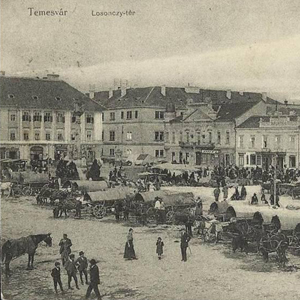
The period of belonging to the Hungarian Kingdom within the Austrian and Hungarian Monarchy 1867-1918.
After the defeat in the war with Prussia, the Austrian Empire split into Austria and Hungary, becoming the “Dual Monarchy” of Austria - Hungary in 1867. In Timisoara, in the administration, the Hungarian language is introduced.
In 1868, the Esplanade - the plain around the city, where building was prohibited, was reduced to 569 m. This allowed the development of the districts outside the city centre, especially after 1890, along some boulevards, which still exists today.
In 1892 the decision to cancel the status of military fortress city was taken. From 1899, the demolition of the fortifications started. The city’s main functions were economic, especially trading and banking. The industrial production developed, especially light industry branches.
Urban planning was drawn up, presenting the joining of the central district, Cetate, with the districts around it. Along the Bega channel a chain of parks was designed, partly surrounding the Cetate District. The planning for the construction of wide boulevards was drawn up, from the central district to other districts and the streets on a circular route around the citadel (the Diaconovici Loga and Eminescu boulevards).
In 1902, the current route of the Bega canal in the Fabric District was projected, canal executed at the same time with the afferent bridges for the streets that crossed it, until 1910.
Between 1905 – 1913, a strong constructive development in all the districts took place. The buildings usually formed continuous fronts of buildings on two or three levels. Sometimes sidewalks were separated from the road surface by planted green strips.
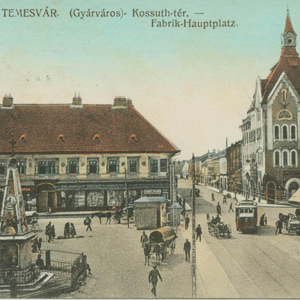 During this period, the December 16, 1989, boulevard was completed, linking the Elisabetin and Iosefin Districts with the Cetate District. In the Fabric District, August 3rd, 1919, boulevard is completed, towards the Cetate District. The three fronts of the Plevna Square were completed in the Elisabetin District.
During this period, the December 16, 1989, boulevard was completed, linking the Elisabetin and Iosefin Districts with the Cetate District. In the Fabric District, August 3rd, 1919, boulevard is completed, towards the Cetate District. The three fronts of the Plevna Square were completed in the Elisabetin District.
On the cleared lands, after the demolition of the fortifications, the Piarist High School and most of the buildings in the Victoria Square, from the Opera to the cathedral, were completed.
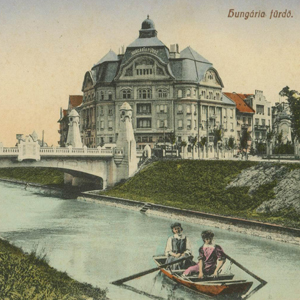 The buildings of this period have a monumental feature, matching the scale of their contemporary European cities. Especially the building corners are finished in the form of towers or small constructions. They are underlined by high roofs, with compositions characterized by impressive large volumes. Fronts have a rich ornamental decoration.
The buildings of this period have a monumental feature, matching the scale of their contemporary European cities. Especially the building corners are finished in the form of towers or small constructions. They are underlined by high roofs, with compositions characterized by impressive large volumes. Fronts have a rich ornamental decoration.
The visual expression of these buildings reflects many styles, which bear different names (Art Nouveau, Sezession, szeceszió etc.). Without going into unnecessary details, for a short presentation, we cover all of them under the generic “The architecture of the 1900s”.
In this period, part of the chain of parks along the Bega Canal was completed. Some examples of industrial architecture are interesting too.
The period of belonging to the Romanian Kingdom 1919-1947

Following the defeat of the Dual Monarchy in World War I 1914 - 1918, Timisoara was occupied by Serbian troops (November 14th – 15th, 1918) and French troops (December 2nd, 1918). The Romanians formed the majority of the population, the absolute majority in the eighteenth century and relative in 1918. In Timisoara the relative majority was composed of Germans (43.9% in 1910).
The Romanian delegates that despite the opposition of the new Serbian authorities “could slip” on December 1, 1918 to Alba Iulia, proclaimed the unification of Banat with Romania. This unification was accepted by the great powers that won the war. On July 28th, 1919, the Romanian administration was installed, and on August 3rd, Romanian troops entered the city. Timisoara became the administrative residence of the Timis – Torontal County of the Romanian Kingdom.
In 1920, “the Polytechnic School” was founded. In addition to the economic functions, held previously, Timisoara acquired a new function that of a university centre. This function assured a strong development compared with other cities, which were not university centres.
Around the central district there appeared numerous districts of villas, located in gardens, villas presenting the specific architecture of the interwar period.
Initially, the architecture of that period did not differ essentially from that of the previous period. There appeared some buildings in the so-called “neo-Romanian” style. Some buildings belonging to this style are wrongly proportioned and break the city’s architectural context.
The Polytechnic Institute complex started implementing, designed in 1922 on Mihai Viteazul Boulevard.
Between the two world wars, the wide boulevards previously designed were completed. The University of Medicine (1924 - 1926), the prefecture (originally designed in 1933, executed from 1938 to 1943) on Revolutia din 1989 Boulevard, were built. Many villas were built on Take Ionescu, Diaconovici Loga, Mihai Eminescu and Mihai Viteazul Boulevards.
 After 1930, many buildings were built in the “cubist” style or “modern, international” style. Some of them, such as the Faculty of Dentistry on Revolutia din 1989 Boulevard, or Campeanu House on Take Ionescu Boulevard, are true masterpieces of this style. Unfortunately, some contemporary owners have seriously altered the appearance of some buildings from this period, as is the case of villas on Academician Alexandru Borza Street.
By rebuilding the façade of the theater (the interior from 1923 to 1928, the façade towards the cathedral rebuilt from 1934 to 1936) and the building of the Romanian Orthodox Cathedral (1936 to 1946) the central square between the opera and the cathedral is completed. Thus, a unique system in Romania has been created, consisting of three urban squares, each with different sizes, stylistic solutions and different architectural styles: the Victoriei Square, the Libertatii Square and the Unirii Square, representing true outdoor fairs.
After 1930, many buildings were built in the “cubist” style or “modern, international” style. Some of them, such as the Faculty of Dentistry on Revolutia din 1989 Boulevard, or Campeanu House on Take Ionescu Boulevard, are true masterpieces of this style. Unfortunately, some contemporary owners have seriously altered the appearance of some buildings from this period, as is the case of villas on Academician Alexandru Borza Street.
By rebuilding the façade of the theater (the interior from 1923 to 1928, the façade towards the cathedral rebuilt from 1934 to 1936) and the building of the Romanian Orthodox Cathedral (1936 to 1946) the central square between the opera and the cathedral is completed. Thus, a unique system in Romania has been created, consisting of three urban squares, each with different sizes, stylistic solutions and different architectural styles: the Victoriei Square, the Libertatii Square and the Unirii Square, representing true outdoor fairs.
The period of communist dictatorship 1947-1989
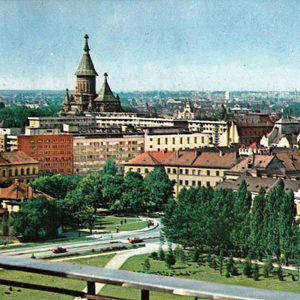
Romania participated in the Second World War from 1941. After defeating the Romanian Army on the Eastern Front, Timisoara was occupied by Soviet troops in September 1944. Under the pressure of occupying troops, the Romanian People’s Republic was proclaimed on December 30th, 1947, and on June 11th, 1948, the state nationalized the main means of production. Despite the sometimes active resistance of the population (demonstrations in the years 1945, 1956, partisans’ fights in Banat Mountains) a Stalinist dictatorship was instituted. The Stalinist terror threw thousands of citizens in concentration camps and prisons.
During this period the constructive activity stagnated.
After the retreat of the occupying troops in 1958, a period of “defrosting” took place, of timid liberalization (1964 to 1970).
In the 1960s, new sets of constructions were completed: the University on Parvan Blvd (1961 - 1965), some “filling” blocks of flats on the existing streets, such as residential blocks with shops at ground floor (1963), which “closed” the front of the Victoria Square, north-east of the Romanian Orthodox Cathedral.
In 1965, Nicolae Ceauşescu came to power. The “cultural revolution” followed and the installation of the Ceausescu’s personal dictatorship (1971 to 1989).
The 1980s were marked by a pronounced economic downturn. Similar to the Stalinist period, the streamlining of the consumer products was introduced.
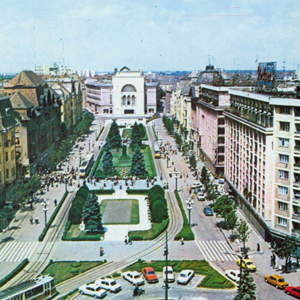 Between 1974 – 1988, huge “bedroom districts” were built, consisting of blocks with four, eight or ten floors, made of large prefabricated panels. In the late 1980s, over two thirds of the population of Timisoara lived in such districts, the Circumvalaţiunii, Şagului or Calea Lipovei Districts etc. The blocks had the technical facilities and utilities necessary for living, but have pathetic look, totally unaesthetic, contrasting sharply with what was built in Timisoara in the previous periods.
Between 1974 – 1988, huge “bedroom districts” were built, consisting of blocks with four, eight or ten floors, made of large prefabricated panels. In the late 1980s, over two thirds of the population of Timisoara lived in such districts, the Circumvalaţiunii, Şagului or Calea Lipovei Districts etc. The blocks had the technical facilities and utilities necessary for living, but have pathetic look, totally unaesthetic, contrasting sharply with what was built in Timisoara in the previous periods.
In the last months of 1989, the mood of most of the people from Timisoara became explosive (see the partial strike from Timisoara Mechanical Factories). The evacuation attempt of the Reformed pastor Laszlo Tokes led to the outbreak of the demonstrations on December 16th and 17th, 1989. In the afternoon hours of December 17th the repressive forces opened fire on the demonstrators. The bloody repression continued on December 18 as well. Dozens of dead and hundreds of wounded people fell those days.
On Wednesday, December 20th, 1989, the streets were dominated by columns of demonstrators, who were moving from the industrial areas to the city centre. The army was withdrawn to the barracks.
Then the communist regime was overthrown in Bucharest as well.
The Revolution won!
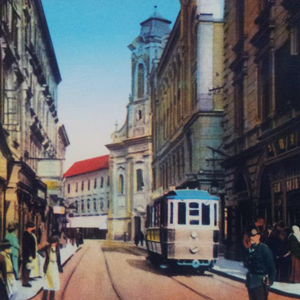
Timisoara during the transition and the market economy periods (from 1990 to the present day)
Following the victory of the Revolution of 1989, Romania returned to parliamentary democracy. The political system based on several political parties was reintroduced.
In this period, a series of new buildings appeared, typical for this stage of development: the BRD Bank on Parvan Blvd, Iulius Mall on Demetriade Street, the Business Centre from 700 Square, and a number of new churches, such as that of the one on Doja St.. Residential villa districts developed on the outskirts of the city.
Today Timisoara lives a new experience: to its economic and cultural functions, the ones of a tourist centre are added. From a city renowned for its economic activity, Timisoara transforms into a tourist city.
We hope Timisoara, the city of parks and of the Revolution, will have a great future to match its glorious past.